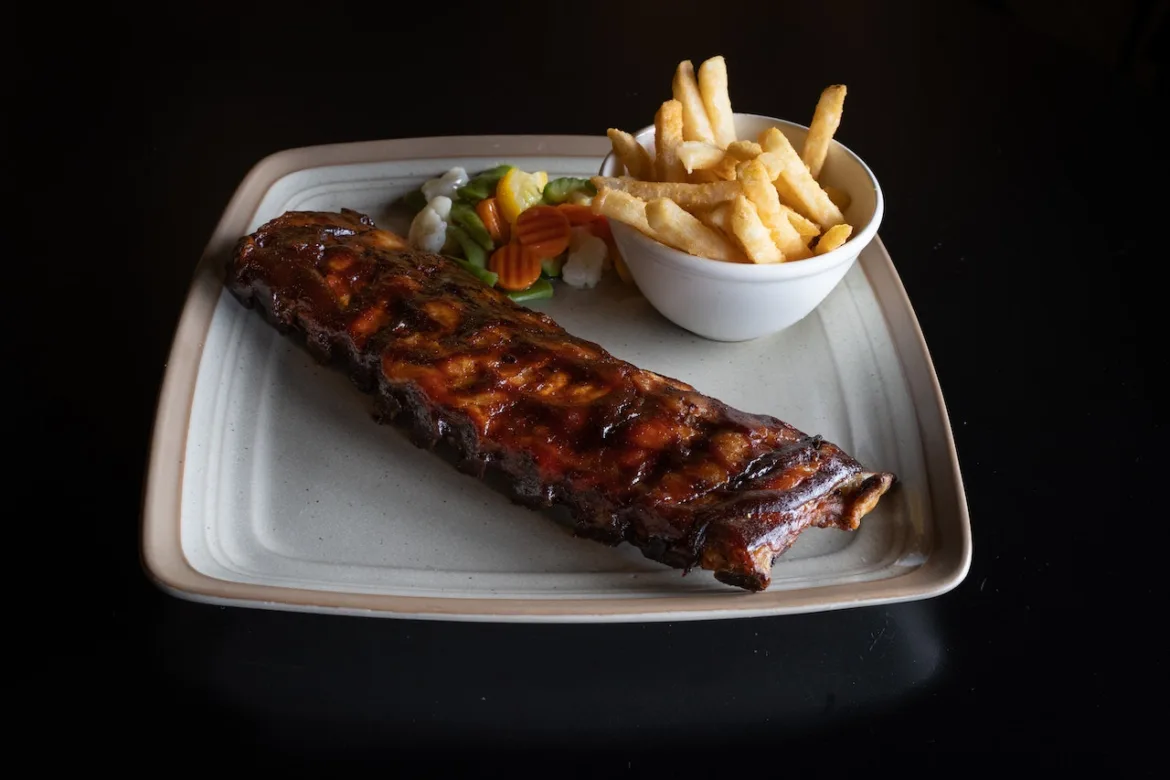Introduction
Few culinary delights can match the sheer satisfaction of sinking your teeth into a slab of perfectly smoked barbecue ribs. The tantalizing aroma, the fall-off-the-bone tenderness, and the explosion of flavour that ensues with every bite are experiences that linger in the memory long after the meal is over.
In the world of barbecue, one dish reigns supreme: BBQ ribs smoked to perfection. In this article, we delve into the art and science of crafting mouthwatering BBQ ribs that will leave you craving for more.
Table of Contents
BBQ Ribs:
The Cut: Choosing the Right Ribs
Before we even start talking about smoking techniques and flavour profiles, the foundation of outstanding barbecue ribs lies in selecting the right cut of meat. The two most popular choices are baby back ribs and spare ribs.

Baby Back Ribs: These are smaller, curved, and meatier ribs that come from the upper part of the pig’s ribcage. They are leaner and cook more quickly than spare ribs, making them a preferred choice for many barbecue enthusiasts. Baby back ribs are often considered more tender, with a slightly sweeter flavour.
Spare Ribs: Spare ribs are larger and have more fat, which makes them incredibly flavorful when properly cooked. They come from the lower part of the ribcage, closer to the belly. Due to their higher fat content, spare ribs can be more forgiving during the smoking process, making them a great choice for beginners.
Ultimately, the choice between baby back and spare ribs is a matter of personal preference. Both can yield mouthwatering results when handled correctly.
The Rub: Flavouring Your Ribs

Creating a tantalizing rub is the next crucial step in the quest for BBQ perfection. A good rub consists of a blend of herbs, spices, and other seasonings that complement the natural flavours of the meat and add depth to the overall taste. Here’s a basic rub recipe to get you started:
- 2 tablespoons brown sugar
- 2 tablespoons paprika
- 1 tablespoon salt
- 1 tablespoon black pepper
- 1 tablespoon garlic powder
- 1 tablespoon onion powder
- 1 teaspoon cayenne pepper (adjust to your desired level of heat)
Feel free to experiment with additional ingredients like mustard powder, chilli powder, or dried herbs to create a unique flavour profile that suits your palate.
The Smoke: Slow and Low

The hallmark of exceptional barbecue ribs is the slow smoking process. Low and slow is the mantra here. This method involves cooking the ribs at a low temperature (around 225-250°F or 107-121°C) over a long period, typically 3-6 hours, depending on the thickness of the meat and your chosen smoking technique.
There are two primary methods for smoking ribs:
- Indirect Heat on a Grill: You can use a charcoal or gas grill set up for indirect heat. Place a drip pan filled with water beneath the ribs to keep them moist, and add wood chips (such as hickory, apple, or mesquite) for that smoky flavour. Maintain a consistent temperature and periodically baste the ribs with your favourite barbecue sauce.
- Smoker: If you have a dedicated smoker, this is the Cadillac of rib-smoking methods. Smokers are designed to maintain a stable temperature and provide an abundance of smoky flavour. The process is largely the same as with a grill, but you have more control over the smoke and temperature.
The Finish: Saucing and Resting

The final touch is all about the sauce. Barbecue sauce is a matter of regional pride, with different styles from all corners of the United States. Whether it’s the tangy, vinegar-based sauce of North Carolina or the sweet and thick molasses-based sauce of Kansas City, the choice is yours. Baste the ribs generously during the last half-hour of cooking, allowing the sauce to caramelize and create that irresistible glaze.
After removing the ribs from the heat, let them rest for about 10-15 minutes. This allows the juices to redistribute within the meat, ensuring that every bite is as juicy as the first.
The Verdict: Perfection Achieved

Mouthwatering BBQ ribs, smoked to perfection, are a labour of love. From selecting the right cut to crafting the perfect rub, mastering the art of low and slow smoking, and finishing with a delectable sauce, every step contributes to creating a memorable dining experience.
So, fire up your grill or smoker, gather your favourite ingredients, and embark on a culinary journey that will leave you and your guests savouring each and every bite of those mouthwatering BBQ ribs, smoked to perfection. It’s a timeless tradition that brings people together and showcases the true artistry of barbecue.
FAQs
What’s the best way to achieve that smoky flavour when smoking ribs?
To achieve that signature smoky flavour when smoking ribs, you should use wood chips or chunks specifically designed for smoking, such as hickory, applewood, or mesquite. Soak the wood chips in water for about 30 minutes before adding them to the grill or smoker. This will create a steady release of flavorful smoke throughout the cooking process.
What’s the ideal internal temperature for perfectly smoked ribs?
The ideal internal temperature for smoked ribs is around 190-203°F (88-95°C). At this temperature range, the connective tissues in the meat have broken down, resulting in tender, juicy ribs. You can use a meat thermometer to ensure your ribs reach this temperature without overcooking them.
How do I prevent my ribs from drying out during the smoking process?
To prevent your ribs from drying out, maintain a consistent cooking temperature and use a water pan underneath the ribs to create a moist cooking environment. Basting the ribs with a flavourful liquid or barbecue sauce during the cooking process will also help keep them moist and add extra flavour.
What’s the difference between baby back ribs and spare ribs, and which one should I choose?
Baby back ribs come from the upper part of the pig’s ribcage and are smaller, leaner, and slightly sweeter in flavour. Spare ribs, on the other hand, are larger, meatier, and have more fat, resulting in a richer, more savoury flavour. The choice between the two depends on personal preference. Baby back ribs are often favoured for their tenderness, while spare ribs are known for their intense flavour.
How long should I let the ribs rest after smoking, and why is this important?
It’s essential to let the smoked ribs rest for about 10-15 minutes after cooking. This resting period allows the juices within the meat to redistribute, ensuring that each bite is flavourful and moist. If you cut into the ribs immediately, the juices may run out, leaving you with drier meat. Resting also helps the ribs hold onto the flavourful rub and sauce, enhancing the overall taste.



